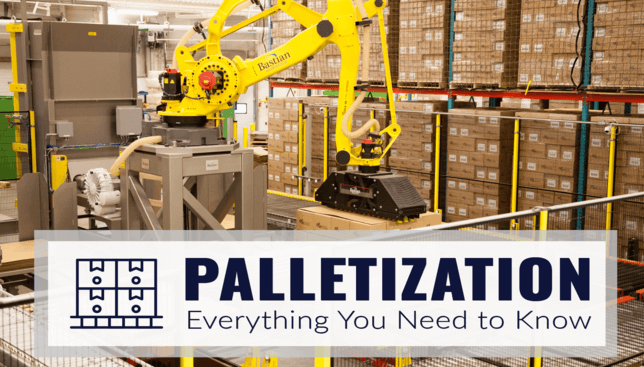Well, you’re in the right place.
Because in this post, you’ll learn:
- What palletization is
- Why palletization is important
- Palletization methods and configurations
- Safety tips when palletizing
- Palletization FAQs
- And more!
Let’s dive in!
What Is Palletization?
Palletization is a logistical process that involves placing goods on top of a pallet to secure and consolidate the load and ease its handling during transportation, storage, handling, and distribution.
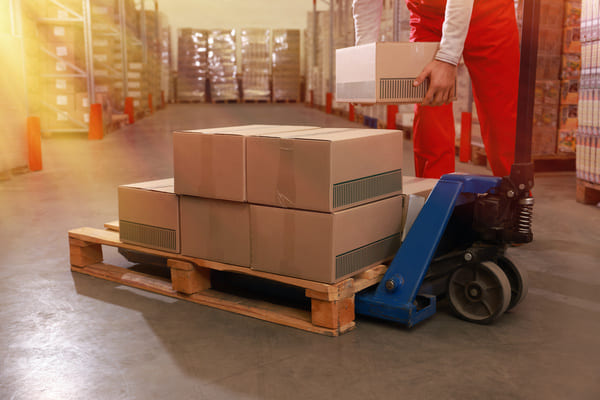
Why Is Palletization Important?
The core advantage of palletization is that it consolidates multiple smaller products into a single unit load, moving as one unit rather than multiple ones, making it easier to handle and transport.
How?
First, a single pallet containing several items is easier to manage during loading and to track during shipment. Second, the universal shapes and sizes of pallets also allow for easy lifting and stacking by forklifts or pallet jacks.
What Are the Benefits of Palletizing Products?
The benefits of palletizing products include:
- Product stability. Palletization consolidates many products into one unit and wraps the pallet with plastic film. The products’ stacking is done according to their weight and in a pattern that promotes stability and integrity.
- Quicker product handling and shipment. Pallets allow faster loading and unloading, product handling, and faster turnaround of shipment/delivery vehicles. This also results in greater transport equipment/delivery efficiency and quicker availability of the transport equipment for the next delivery.
- Portability and transport efficiency. Shipping pallets make items easier to handle and transport. Pallets are easier to stack in trucks, ships, trains, and planes, and shippers have fewer items to track during shipment.
- Less risk of damage. Proper product handling means less exposure to damage. Pallets have universal/standard sizes and shapes, making them easy to handle using either automated machines or manually with forklifts. Also, because pallets are stronger, they can hold heavier products without the risk of damage.
- Reduced labor requirement. Palletization allows easy mechanization and automation of product handling both in the warehouse and during shipment. Forklifts, pallet jacks, and other robotics can easily load and offload items and transport them.
- Reduced risk for operators. Pallets (and automated palletizing) reduce the need for repetitive lifting of heavy loads, which reduces stress injuries and improves the safety of workers and products.
- Better handling of perishable products. Pallets allow rapid handling and transportation of shipments, leading to reduced risk of temperature abuse on perishable products, reducing their risk of spoiling.
- Improved storage utilization. Standard-sized pallets allow stackability, optimizing storage space, warehouse and cube utilization in storage and transport, and improving warehouse operations across supply chains.
- Better inventory control. Palletization allows strict monitoring of SKUs. Since logistics/warehouse managers know each pallet’s merchandise volume, it’s easy to understand each product’s stock level.
Pallets and Palletization: What You Need to Know
Ever wondered how pallets became foundational to logistics today with billions in use?
The demand for pallets continues to run high to transport a wide range of items, from consumer products to industrial ingredients. This eCommerce explosion also drives the growth in demand.
Today, an estimated 5 billion pallets are in use worldwide, 2 billion of which are in the United States. About 90% of these pallets are made of wood, with the rest being out of cardboard, plastic, or metal materials.
Pre-Pallet Material Handling
What came before the pallet?
Before pallets, wood barrels, crates, and skids were commonly used for handling goods.
People may confuse pallets and skids, but they have a difference.
What are skids?
Skids are wooden (sometimes plastic or metal) single platforms on which products are sometimes shrink-wrapped for storage and/or transportation.
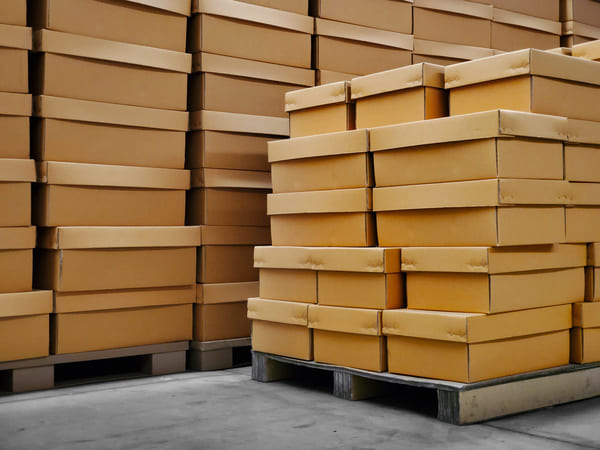
Considered the precursors to pallets, skids have been used as early as the 1st Millennium BC.
The key difference between skids and pallets is the deck boards (platform) where you put the items you’re palletizing. Skids only have a top platform, while pallets have both top and bottom platforms, leaving them to rest on the floor/ground on their stringers.
(Stringers are the two boards running between the bottom and top deck platforms on two ends of the pallet).
There were many problems with the olden days’ wood barrels, crates, and skids, including being labor intensive, inefficient, risky to workers and goods, and difficult to use in moving heavier products.
This necessitated finding a way to easily stack goods, lift heavier products, and move them quickly.
Thus, pallets were invented.
Pallet-Based Material Handling
Pallets are one of the greatest material handling innovations (along with forklifts) of the 20th century.
While the earliest known patent on a skid (pallet precursors) was in 1924, the modern pallet wasn’t patented until 1939.
Then, pallets came into wider use during World War II when forklifts also became more common. The military pioneered the use of both.
The modern pallet was developed out of the need for efficiently handling large quantities of military goods and supplies and quick transportation to troops on the front lines.
After WWII, pallets became established in the freight and supply chain industry. They expedite product movements in various phases such as storage, shipment, and delivery.
What Are Pallets?
Pallet definition: A pallet is a wooden structure (sometimes plastic or metal) with horizontal top and bottom platforms where items are stacked for storage or shipping.
Pallets provide a base and pockets for the forks of a forklift or pallet jack to pick it up, move the load as a whole, and put it in storage, load, or offload.
The modern 2-direction stringer pallet, first introduced in 1925, underwent various modifications from the 1920s to the 1940s to become what it is today.
This pallet impacted the rail car transportation system immensely, taking the 3-day unloading of about 13,000 unpalletized cases to just a 4-hour task.
Pallet Sizes
Pallets come in different sizes and dimensions based on the materials they handle, weight, shapes, and industry.
What is the standard pallet size?
According to the GMA (Grocery Manufacturers Association), the standard pallet size is the GMA pallet 48 x 40-inches.
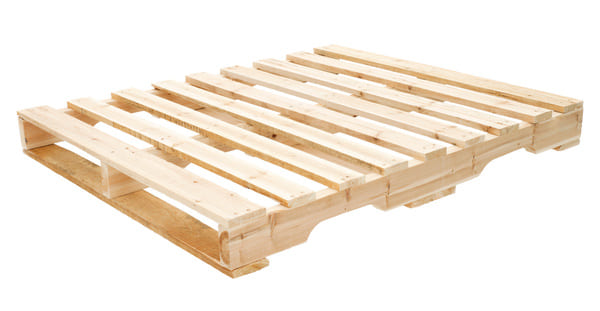
They’re the most common pallet sizes, versatile, and widely used pallets. These pallets can hold up to 4,600 lbs. loads.
GMA 48 x 40-inch pallets represent 35% of all pallets produced and used.
They’re usually 6.5-inches tall and weigh an average of 37 lbs., (or heavier) with deck boards of 3.25-inches wide, 40-inches long, and 0.31-inches thick.
What are the common pallet sizes?
Common GMA standard pallet sizes in the U.S. include:
- 48 x 48-inch
- 42 x 42-inch
- 36 x 48-inch
- 36 x 36-inch
- Half pallets (24 x 20-inch). They’re half the size of the standard GMA 48 x 40-inch pallets.
Other than the standard pallet sizes, more pallet sizes can be used in the market, depending on the industry.
Here is a classification of pallet sizes based on their use:
- 48 x 40-inch (Grocery)
- 48 x 48-inch (Drums)
- 48 x 45-inch (Automotive)
- 40 x 40-inch (Dairy)
- 42 x 42-inch (Telecommunication, paint)
- 36 x 48-inch (Beverages, packaged paper, shingles)
- 36 x 36-inch (Beverages)
- 44 x 44-inch (Chemical, drums)
- 40 x 48-inch (Military, cement)
- 48 x 20-inch (Retail)
- 54 x 44-inch (Glass containers)
- 24 x 20-inch (Retail)
What Are the Types of Pallets?
Pallet designs are specifically meant to allow them to be lifted by forks on forklifts or pallet jacks.
Pallet Materials
While most pallets have the same configurations, there are different pallet materials, namely:
- Wood (90% of pallets) made of recycled wood, hardwood, plywood, or presswood.
- Plastics
- Metal
- Cardboard
- Corrugated paper
The difference in materials is because some industries have particular requirements for pallets and pallet composition based on the materials they handle.
Common Types of Pallets
Other than their materials, pallets also have different designs based on the items they handle:
- Block/Deck Board Pallets: These are pallets with four-way entry, meaning forklifts can access them on all four sides. They can be made of wood, metal, plastic, or plywood and usually have four to 12 columns for the stability of top deck boards. They may or may not have lower deck platforms.
- Stringer Pallets. These are two-way pallets with stringers to support the load. Four-way stringer pallets can have notched stringers or be block designs to allow folks to pick up the pallet.
- Double-Face Pallets. While most pallets only have top (single) platforms or decks, doubles-faced pallets have top and bottom (double) platforms. The bottom deck provides increased strength to the pallet allowing it to lift heavy loads. The double-face pallets can be reversible (hold goods on either face) or non-reversible (uses only one surface.)
- Double Wing Pallets. This is a pallet designed with the top and bottom deck platforms extending beyond them to provide additional surface area. The wings provide additional space to accommodate more goods.
- Solid Deck Pallets. The platform (deck) is a single, continuous sheet of material (wood, plastic, or metal) with no spacing. They’re used to transport smaller items and are easy to clean.
Key Advantages of Pallets
Pallets have undergone some key advancements since their invention. These improvements are seen in their design, handling, material, weight, and sizes.
Computers and software also allow the digital design and testing of pallets, making them more diverse, versatile, and useful. These designs also allow the use of palletizing machines.
The key advantages of modern pallets include:
High Capacity per Weight
Compared to other holding equipment like cardboard and plastic, pallets are more versatile, allowing them to carry much heavier items without damaging the product or pallet.
A single pallet allows the stacking of heavier items on top of one another without worrying about breaking them.
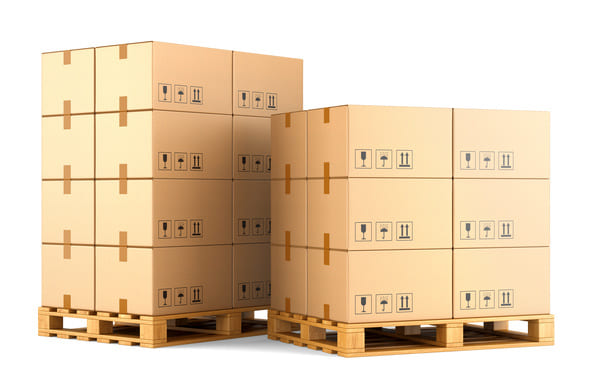
What is the average pallet capacity?
A standard GMA pallet 48 x 40-inches pallet can hold up to 4,600 lbs. However, pallets’ weight may vary depending on size and material.
Faster to Transport
Pallets allow rapid transportation of large quantities of items and faster loading and unloading of items. Indeed, part of their popularity is because the military used pallets to transport weapons and supplies quickly to soldiers on the frontline.
Expedite Product Movements
Since pallets work well with many material handling equipment, like forklifts, they enable quick and efficient product lifting without much manual labor. This reduces injury risk and the chance of product damage.
Inventory Control and Monitoring
Palletization allows monitoring of SKUs across all phases of the supply chain: goods receipt, storage, shipment, and delivery.
Types of Palletizing
There are 3 types or methods of palletizing:
- Manual palletizing
- Semi-automated palletizing
- Automated palletizing
Let’s go through each in more detail.
Manual Palletizing
This palletizing method involves using manual force, such as by hand, to place items on pallets.
For example, a factory worker lifting boxes off an assembly line conveyor and stacking them onto a pallet on the floor is manual palletizing.
The advantage of manual palletizing is that it requires no expensive machinery, and thus is the cheapest method.
The disadvantage is that it can be a long, drawn-out process that takes time away from other tasks. It’s also prone to injuries like back strain from heavyweights and can heighten the risk of damage to goods.
Semi-Automated Palletizing
In semi-automated palletizing, the palletization process begins manually (by hand) and ends automatically using automatic palletizer machines.
For example, while the pallet wrapping is automatically done, building the pallet unit load is done manually by one or two workers.
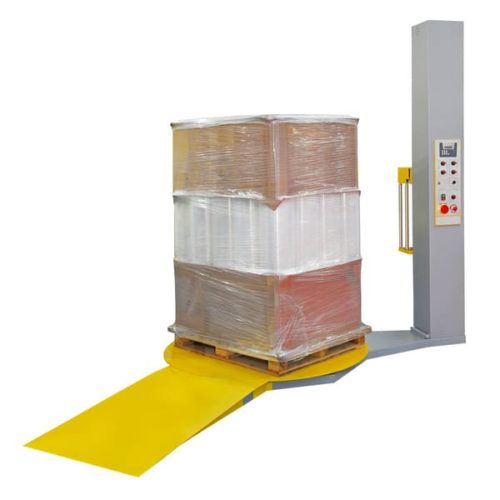
The advantages of semi-automated palletizing include:
- Allows for faster throughput rates compared to manual palletizing.
- Increases efficiency by keeping the pallet’s top platform at an ergonomic height for workers.
- Reduces bending and the risk of back strain and other palletizing injuries.
- Adds stability and strength to the pallet, allowing the building of taller loads without the risk of collapse and damage products.
- Maintains flexibility of manual palletizing.
- Can work with cases, skids, pallets, trays, and totes.
The main disadvantage of semi-automated palletizing is that it doesn’t eliminate the human element, which can result in worker injuries, mistakes, and inefficiencies.
Automated (Robotic) Palletizing
Automated palletizer definition: Automated (robotic) palletizing is the full use of a palletizing machine or robot to load goods on a pallet. They typically work well in automated warehouses.
Common uses for automated palletizing include packaging, shipping, distribution, and other handling applications. They’re used in many industries such as food processing, agriculture, electronics, warehousing, retail, commercial and pharmaceutical.
Advantages of Automated Palletizing
- Faster loading and unloading speeds, increasing efficiency and throughput.
- Reduce labor needs and costs by 75% or more compared to manual palletizing. Robots can reduce the number of workers needed to palletize products to as low as a single operator occasionally delivering pallets to the palletizer cell.
- Continuous operations, reliability, and stability. Robots can work around the clock. As long as the products are fed, and machines are running, the robots will function. This can free up employees for other value-added tasks.
- Removes the need to lift heavy objects manually.
- Better use of floor space. Automatic palletizing saves floor space crowded by workers, sometimes up to 50%. Standard-size pallets allow easy arrangement and are compatible across different supply chains.
- Improved ergonomics and reduced worker-related injuries such as back strains, fatigue, etc.
- Palletizing equipment can handle repetitive work allowing workers to do other tasks.
- Faster turnaround for delivery vehicles. This creates better fuel efficiency/less impact on the environment and gives vehicles quicker availability for the next arrival.
- Easier to handle perishable goods because of speed in loading and faster turnaround for delivery vehicles.
Disadvantages of Automated Palletizing
- Higher initial and continuing capital costs to purchase, install, operate, and maintain the robotic machines.
- Re-programming the robots can be expensive when there are changes in the products or production process.
Types of Automated Palletizers
There are two basic types of automated palletizers:
- Conventional (in-line) palletizers
- Articulated robotic arm palletizers
Conventional Palletizers
Conventional palletizers were first introduced in the 1950s to support palletization. They’re currently used in many industries like food, automotive, beverage, paper, pharmaceutical, retail, chemical, and personal care.
Advantages of Conventional Palletizing
- Quicker because of high-speed.
- Handle high volumes of packaging.
Disadvantages of Conventional Palletizing
- Can only be used to handle a single type of product.
- Use larger floor spaces.
Articulated Robotic Arm Palletizers
Robotic (automatic) palletizers were first introduced in the early 1980s. It’s the newest addition to palletizers.
Typically, robotic palletizers are stationed between a conveyor line of the incoming product units and a pallet dispenser.
The robot arms (end effector or gripper), sometimes controlled using palletization software, pick products from the conveyor (layer table) and put them onto a pallet.
Palletizing robots are currently used in various industries such as food, paper, automotive, beverage, pharmaceutical, chemical, and consumer products.
Advantages of Robotic Arm Palletizers
- Can handle products individually or multiple pallets at once.
- Can handle different-sized packages.
- Can arrange products in different ways.
- Can palletize several different types of products on 1 pallet.
- Require a smaller footprint.
Disadvantages of Robotic Arm Palletizers
- Low tolerance for pallet variance. Wood pallets can splinter, expand, and contract as they absorb moisture. Using plastic pallets can help prevent this.
- More expensive to acquire and maintain compared to conventional palletizers.
- Since they work in so many more dimensions and operate in a more finessed environment, the product size, shape, and quality of the packing material can be challenging.
Conventional vs. Robotic Palletizing
| Aspect | Conventional Palletizing | Robotic Palletizing |
|---|---|---|
| Cost | Less expensive to install and maintain | More expensive to install, maintain, and upgrade |
| Speed | Higher-speed palletization operations | Lower speed, but excels in precise and flexible movements. |
| Volume | High-volume palletizing | High-volume palletizing |
| Pallet variance/complexity | Tolerance to pallet and goods variance, including different sizes and cases | Low tolerance to pallet variance; adept at stacking individual units in various ways; can’t handle variations between cases. |
| Product types | Works well with consistently shaped and sized packages | Can handle almost any type of package |
| Floor space | Require larger operation spaces | Are smaller and use little floor spaces (require smaller footprint) because they can achieve 240 degree functionality. |
Hybrid Robotic Palletizers
It’s also common to see both types of palletizers in 1 facility. For example, manufacturing and logistics switching to omnichannel (i.e. single production line that handles many types of products).
An alternative solution to this is a hybrid robotic palletizer. This is where a robotic armature is integrated into a controlled entry conventional frame.
This type of configuration can achieve space-saving, safety, and stretch wrapping features of a conventional palletizer to handle bags and other delicate products.
Pallet Configurations
How containers/items are stacked on pallets is referred to as pallet configuration.
Pallet configuration data is composed of the type and sizes of pallets used (e.g. standard, four-way, Euro pallet), stacking pattern, the height of layers, and the number of cases per pallet and row.
There are different types/patterns of pallet configuration/stacking:
- Column pallet stacking
- Brick pallet stacking
- Interlocking pallet pattern
Other pallet configuration methods are split row, hybrid, and pinwheel patterns.
Let’s go through each one in more detail.
Column Pallet Stacking
Column stacking is when cartons/cases are arranged to maintain the same footprint up the pallet as they’re stacked directly on top of each other.
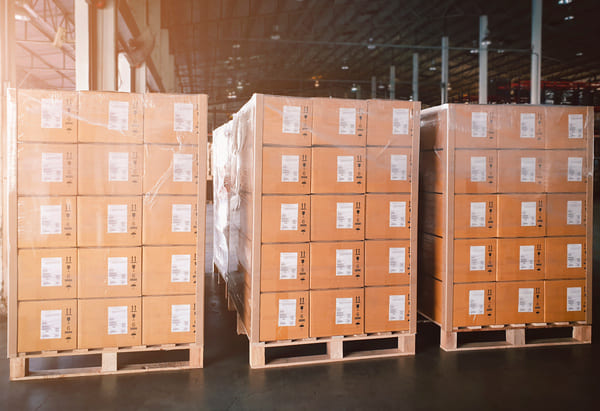
The cartons/cases are stacked in a manner that puts the corner of each carton directly on the corner of the carton below it. This pattern can sometimes allow economizing on the cartons’ board grade.
Advantages of column stacking include:
- Gives the whole stack maximum strength.
- Provide greater resistance than brick or interlocking.
- Maximizes weight and volume while being stable.
- Prevent shifting, toppling, and crushing.
Disadvantages of column stacking include:
- Works best with lighter-density loads such as fragile or soft contents.
- Can be more susceptible to toppling if stacked too tall.
Brick Pallet Stacking
Typically, brick stacking is when the carton’s footprints are switched on every layer to form a brick-like architecture and allow the cartons to interlock.
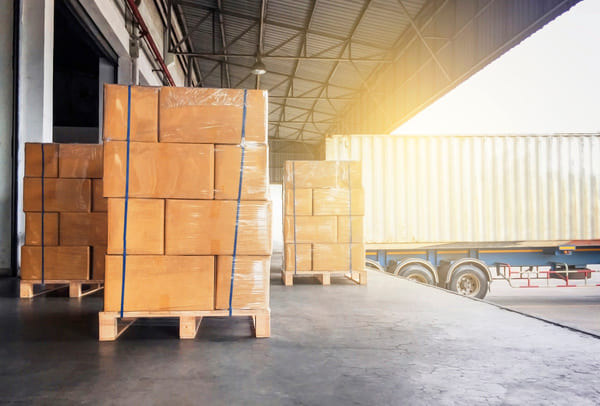
Advantages of brick stacking include:
- Give a stronger pallet configuration.
- Provides a proper arrangement to prevent shifting, toppling, and crushing.
- Allows mixing of carton/box sizes.
Disadvantages of brick stacking include:
- Reduces the number of boxes per pallet.
Interlocking Pallet Patterns
An interlocking pallet pattern uses a rotating footprint stacking method where more than one box below supports the box above.
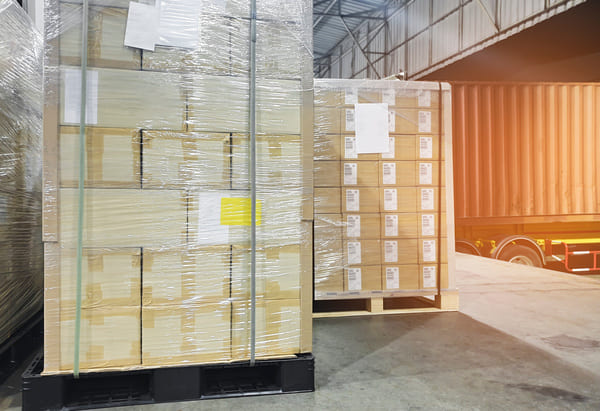
It’s a superior palletization method because of the increased stability of boxes.
Advantages of interlocking pallet patterns include:
- Best for higher-density loads, like canned goods.
- Greater unit load stability.
- Better bridging strength.
- Reduced pallet deflection.
The main advantage of using the interlocking pallet pattern is that it’s slightly more complicated to construct than brick or column stacking.
Disadvantages of interlocking stacking include:
- Allow fewer goods per pallet.
- This may create pressure on individual boxes due to uneven weight distribution.
How to Palletize a Shipment
How do you palletize a product to ready it for shipment?
Not many people understand how to palletize boxes. But with practice, this process is simple and direct.
Palletizing a shipment has two phases:
- Loading
- Securing
Loading
Loading is the act of placing product cartons or cases on the pallet.
The key aspects of loading are:
- Stack the load (boxes/cartons) uniformly. Use the preferred stacking pattern: column, brick, or interlocking.
- Distribute the weight evenly for both the weight inside each box and how each is distributed on the pallet.
- Aim for compact, stable loads. The heaviest items should be at the bottom of the pallet. The more delicate items shouldn’t get crushed. The pallet load should be steady and less likely to fall or topple in transit.
- Prevent deformation. Don’t allow deflection that can cause deformation. Use flat empty cardboard on every couple of rows to help solidify loose boxes.
- Don’t allow overhang or misalignment. Overhang risks falling over. Ensure the boxes fit onto the pallet correctly without exceeding the pallet dimensions.
Securing
Once the unit load is stacked correctly on the pallet, it’s important to secure it before it’s sent off for shipping.
This can be done by wrapping the unit load with stretch film, which relies on elasticity to hold the items together.
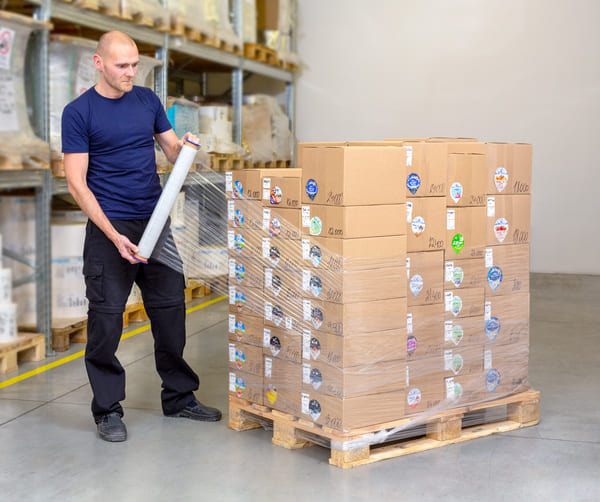
You can also use shrink-wrapping, except that the film will loosely cover your items, and then you’ll apply heat to shrink. This will enable it to hold the items tightly.
Both the wrappings protect the item from moisture and dirt, are cost-effective, and are adaptable to all cargo shapes and sizes.
Alternatively, you can strap or band the product on the pallets. You can do this alone or in addition to the wrapping for extra security.
6 Palletizing Safety Tips
1. Prevent Motion Among Smaller Units
A single carton shifting at the base can cause toppling, damage, and injury. Take all precautions to prevent the motion of the boxes or products.
2. Fill Boxes Fully to Eliminate Empty Space
Don’t stack empty boxes because they can be crushed during the pallet’s movement.
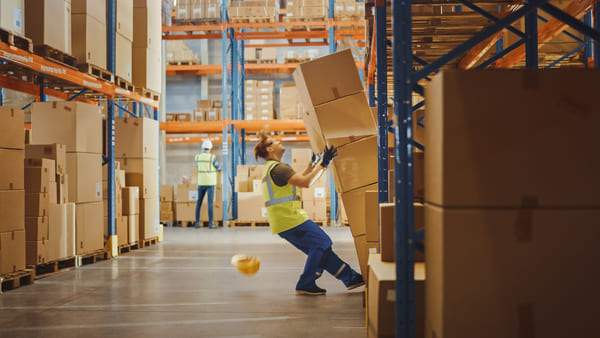
The gaps created by crushed corners can cause a shift in motion of the stacks, toppling, crushing, and other dangers. All boxes must be filled with products or additional packaging to help prevent crushing.
Pack smaller boxes into larger cardboard containers to ensure they don’t create any motion.
3. Distribute Weight Evenly
Stack the heaviest items (in the load) at the bottom, and spread weight evenly across the pallet. Having larger/heavier boxes on the bottom of the pallet creates a solid foundation and resists leaning.
Ensure the edges of the boxes aligned are with the edge of the pallet.
Prevent overhangs, which can act as bumpers and cause toppling, crashing, and other dangers.
4. Avoid Pyramids
Keep the rectangular or square shape of the pallet up to the top and avoid making a pyramid.
The pyramid shape can compromise the stack’s integrity and cause toppling, falling, crashing, and other damages.
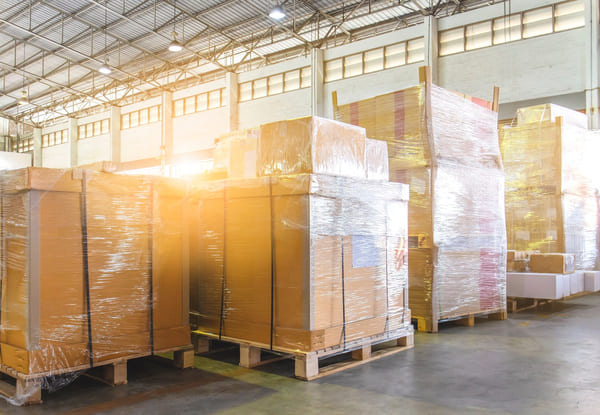
If you have smaller boxes, first place them in a larger stack. If possible, place the smaller boxes carefully into the stack to fill gaps and give it an overall cubic or rectangle shape.
5. Fill All Gaps
Unless specified, alternate the stacking pattern between layers to make them tight and avoid creating gaps.
If left unattended, gaps can open up during the pallet’s motion and cause damage. Make sure there are no gaps vertically or horizontally.
Use flat cardboard sheets to create a level surface between layers if needed.
6. Wrap Tight
After tightly stacking, use 3 to 5 layers of plastic wrap when wrapping the goods to make them tight and bind them to the pallet.

If necessary, use cardboard corner protectors to protect items and further stabilize the load.
If you have smaller boxes, you can pack them into larger cardboard containers to improve their stability.
Palletization FAQs
What Is Palletizing in a Warehouse?
In a warehouse, palletization of products refers to arranging goods/materials on pallets to improve and facilitate their storage, handling, and shipment. Goods are typically laid down on a pallet in a specific order, whether by size, weight, destination, or another criterion.
What Does It Mean to Palletize a Shipment?
Palletizing a shipment involves stacking large quantities of similar products onto a pallet to make them ready for shipping.
The products’ stacking is done according to their weight and in a pattern that promotes their stability and integrity.
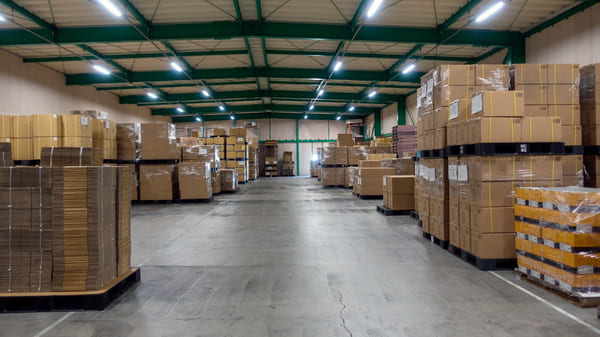
Palletizing is the process of stacking products onto a pallet to make them ready for shipping or storage
In a traditional order fulfillment process, a 3PL picks items (one or more), prepares and boxes the order, and then ships it to the customer. But palletization is different.
In the palletized shipping process, multiple similar products (sometimes cases of merchandise) are stacked onto pallets and secured by wrapping them with plastic film for bulk shipping.
Initially, palletization was manually done, but technology has improved, and now palletizing machines and robots make the process faster and safer.
What Is the Difference Between a Skid and a Pallet?
The key difference between skids and pallets is the deck boards. This is the platform where you put the items you’re palletizing. Skids have only top platforms, while pallets have both top and bottom platforms leaving them to rest on the floor/ground on their stringers.
How Does Palletization Help in Transportation?
Palletization is a faster, surer, and safer way of shipping and transporting cargo. It eases the handling (loading and unloading) and storing of products on vehicles.
What Is Pallet Deflection?
Pallet deflection is the bowing of the footprints or corners. Deflection is typically a result of overloading. One way to reduce deflection is by using an interlocking pallet pattern, which helps protect the corners.
What Is Bridging Strength?
Bridging strength in pallet stacking is the ability of cartons to withstand a downward force without deflecting, shifting, toppling, or crushing.
What Is “Ti Hi” in Palletization?
Pallet Ti Hi is a figurative representation of the layers and number of boxes on a pallet where:
- Ti: number of boxes per layer
- Hi: how many layers high
For example, a 7 x 5 Ti Hi pallet configuration means the pallet is constructed with 7 containers per layer and 5 layers high.
What Is a Palletizer?
A palletizer is a process machine used to stack and organize products onto pallets. A palletizer sorts, transfers, and stacks finished products onto a pallet automatically.
It can be a hand-operated, simple machine or a robotic machine for handling complex and heavy material handling tasks.
Who Invented the Palletizer?
Fuji Yusoki Kogyo invented the first robotic palletizer in 1963, just 2 years after the invention of the first industrial robot. In the 1980s, articulated robot arms were introduced in palletizing.
What Does a Palletizer Do?
Palletizers take containers from the end of a conveyor and assemble them on the pallet into a prescribed pattern, building layers of the product onto a pallet. This creates a unit load.
What is a unit load and why is it important?
A unit load is the assembly of materials stacked and combined on a pallet for efficient handling.
The concept of the unit load is important in logistics because it’s efficient, faster, and more economical to move large, single units (on a pallet) instead of several small, individual items.
Usually, palletizers are part of a bigger packaging process in a conveyor that includes other functions like counting, weighing, sorting, labeling, wrapping, and even metal detection.
Some palletizers have these functions integrated, while some of the activities are done by separate equipment.
How Do Palletizing Robots Work?
A pallet is deposited into the pallet loading area, either by the palletizing robot or an automated pallet dispenser.
The palletizing robot picks products, one (or multiple), at a time, then accurately and quickly places them on the pallet. The palletizing pattern is constructed layer by layer, based on the chosen palletizer, utilizing tier or slip sheets if needed.
What Should You Look for When Buying an Automated Palletizer?
Pallets and palletizers are critical equipment for warehousing and transporting equipment. The palletizer size and loading capacity depend on your business requirements, in addition to:
- Handling equipment. What type of equipment will you use: manual or automatic? The palletizer you acquire should be based on this equipment.
- Type of products. The goods you’ll be handling/transporting/shipping are the most important aspect to consider when buying a palletizer. Consider things like the weight, type, condition, etc. to help you determine the right palletizer.
- Packaging dimensions. Consider the packaging width and height of the items to be shipped to help you choose the right palletizer.
- Floor spacing. The amount of floor space you have will help determine the type, size, and model of the palletizer you go for. If you have a large space and budget, you can get a larger palletizer.
- Frequency of use. If you’ll be using a palletizer less frequently, you can consider semi-automated or smaller ones. If you’re a heavy user, consider acquiring a larger, more efficient one.
- Budget. Ultimately, it’s your budget that will determine what you buy. If you have the budget, go for the best in the market. If not, find something that will serve your needs.
Conclusion
That’s it: Everything you need to know about palletization.
